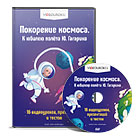NASA
Historical spaceflight programs X-15 (1954–1968)
Main article: North American X-15

X-15 in powered flight
NASA inherited NACA's X-15 experimental rocket-powered hypersonic research aircraft, developed in conjunction with the US Air Force and Navy. Three planes were built starting in 1955. The X-15 was drop-launched from the wing of one of two NASA Boeing B-52 Stratofortresses, NB52A tail number 52-003, and NB52B, tail number 52-008 (known as the Balls 8). Release took place at an altitude of about 45,000 feet (14 km) and a speed of about 500 miles per hour (805 km/h).[61]
Twelve pilots were selected for the program from the Air Force, Navy, and NACA. A total of 199 flights were made between June 1959 and December 1968, resulting in the official world record for the highest speed ever reached by a crewed powered aircraft (current as of 2014), and a maximum speed of Mach 6.72, 4,519 miles per hour (7,273 km/h).[62] The altitude record for X-15 was 354,200 feet (107.96 km).[63] Eight of the pilots were awarded Air Force astronaut wings for flying above 260,000 feet (80 km), and two flights by Joseph A. Walker exceeded 100 kilometers (330,000 ft), qualifying as spaceflight according to the International Aeronautical Federation. The X-15 program employed mechanical techniques used in the later crewed spaceflight programs, including reaction control system jets for controlling the orientation of a spacecraft, space suits, and horizon definition for navigation.[63] The reentry and landing data collected were valuable to NASA for designing the Space Shuttle.[64]
Project Mercury (1958–1963)
Main article: Project Mercury
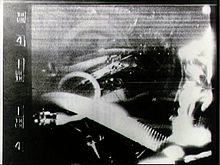
L. Gordon Cooper, photographed by a slow-scan television camera aboard Faith 7 (May 16, 1963)
In 1958, NASA formed an engineering group, the Space Task Group, to manage their human spaceflight programs under the direction of Robert Gilruth. Their earliest programs were conducted under the pressure of the Cold War competition between the US and the Soviet Union. NASA inherited the US Air Force's Man in Space Soonest program, which considered many crewed spacecraft designs ranging from rocket planes like the X-15, to small ballistic space capsules.[65] By 1958, the space plane concepts were eliminated in favor of the ballistic capsule,[66] and NASA renamed it Project Mercury. The first seven astronauts were selected among candidates from the Navy, Air Force and Marine test pilot programs. On May 5, 1961, astronaut Alan Shepard became the first American in space aboard a capsule he named Freedom 7, launched on a Redstone booster on a 15-minute ballistic (suborbital) flight.[67] John Glenn became the first American to be launched into orbit, on an Atlas launch vehicle on February 20, 1962, aboard Friendship 7.[68] Glenn completed three orbits, after which three more orbital flights were made, culminating in L. Gordon Cooper's 22-orbit flight Faith 7, May 15–16, 1963.[69] Katherine Johnson, Mary Jackson, and Dorothy Vaughan were three of the human computers doing calculations on trajectories during the Space Race.[70][71][72] Johnson was well known for doing trajectory calculations for John Glenn's mission in 1962, where she was running the same equations by hand that were being run on the computer.[70]
Mercury's competition from the Soviet Union (USSR) was the single-pilot Vostok spacecraft. They sent the first man in space, cosmonaut Yuri Gagarin, into a single Earth orbit aboard Vostok 1 in April 1961, one month before Shepard's flight.[73] In August 1962, they achieved an almost four-day record flight with Andriyan Nikolayev aboard Vostok 3, and also conducted a concurrent Vostok 4 mission carrying Pavel Popovich.
Project Gemini (1961–1966)
Main article: Project Gemini
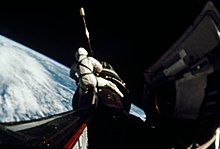
Richard Gordon performs a spacewalk to attach a tether to the Agena Target Vehicle on Gemini 11, 1966
Based on studies to grow the Mercury spacecraft capabilities to long-duration flights, developing space rendezvous techniques, and precision Earth landing, Project Gemini was started as a two-man program in 1961 to overcome the Soviets' lead and to support the Apollo crewed lunar landing program, adding extravehicular activity (EVA) and rendezvous and docking to its objectives. The first crewed Gemini flight, Gemini 3, was flown by Gus Grissom and John Young on March 23, 1965.[74] Nine missions followed in 1965 and 1966, demonstrating an endurance mission of nearly fourteen days, rendezvous, docking, and practical EVA, and gathering medical data on the effects of weightlessness on humans.[75][76]
Under the direction of Soviet Premier Nikita Khrushchev, the USSR competed with Gemini by converting their Vostok spacecraft into a two- or three-man Voskhod. They succeeded in launching two crewed flights before Gemini's first flight, achieving a three-cosmonaut flight in 1964 and the first EVA in 1965. After this, the program was canceled, and Gemini caught up while spacecraft designer Sergei Korolev developed the Soyuz spacecraft, their answer to Apollo.
Apollo (1960–1972)
Main article: Apollo program
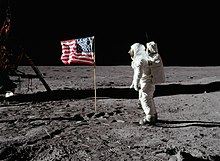
Buzz Aldrin on the Moon, 1969 (photograph by Neil Armstrong)
The U.S public's perception of the Soviet lead in the Space Race (by putting the first man into space) motivated President John F. Kennedy[77] to ask the Congress on May 25, 1961, to commit the federal government to a program to land a man on the Moon by the end of the 1960s, which effectively launched the Apollo program.[78]
Apollo was one of the most expensive American scientific programs ever. It cost more than $20 billion in 1960s dollars[79] or an estimated $236 billion in present-day US dollars.[80] (In comparison, the Manhattan Project cost roughly $30.1 billion, accounting for inflation.)[80][81] It used the Saturn rockets as launch vehicles, which were far bigger than the rockets built for previous projects.[82] The spacecraft was also bigger; it had two main parts, the combined command and service module (CSM) and the Apollo Lunar Module (LM). The LM was to be left on the Moon and only the command module (CM) containing the three astronauts would return to Earth.[note 2]
The planned first crew of 3 astronauts were killed due to a fire during a 1967 preflight test for the Apollo 204 mission (later renamed Apollo 1).[83] The second crewed mission, Apollo 8, brought astronauts for the first time in a flight around the Moon in December 1968.[84] Shortly before, the Soviets had sent an uncrewed spacecraft around the Moon.[85] On the next two missions docking maneuvers that were needed for the Moon landing were practiced[86][87] and then finally the Moon landing was made on the Apollo 11 mission in July 1969.[88]
The first person to walk on the Moon was Neil Armstrong, who was followed 19 minutes later by Buzz Aldrin, while Michael Collins orbited above. Five subsequent Apollo missions also landed astronauts on the Moon, the last in December 1972. Throughout these six Apollo spaceflights, twelve men walked on the Moon. These missions returned a wealth of scientific data and 381.7 kilograms (842 lb) of lunar samples. Topics covered by experiments performed included soil mechanics, meteoroids, seismology, heat flow, lunar ranging, magnetic fields, and solar wind.[89][page needed] The Moon landing marked the end of the space race; and as a gesture, Armstrong mentioned mankind when he stepped down on the Moon.[90]
Apollo set major milestones in human spaceflight. It stands alone in sending crewed missions beyond low Earth orbit, and landing humans on another celestial body.[91] Apollo 8 was the first crewed spacecraft to orbit another celestial body, while Apollo 17 marked the last moonwalk and the last crewed mission beyond low Earth orbit. The program spurred advances in many areas of technology peripheral to rocketry and crewed spaceflight, including avionics, telecommunications, and computers. Apollo sparked interest in many fields of engineering and left many physical facilities and machines developed for the program as landmarks. Many objects and artifacts from the program are on display at various locations throughout the world, notably at the Smithsonian's Air and Space Museums.
Skylab (1965–1979)
Main article: Skylab
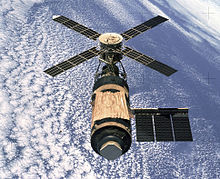
Skylab in 1974, seen from the departing Skylab 4 CSM.
Skylab was the United States' first and only independently built space station.[92] Conceived in 1965 as a workshop to be constructed in space from a spent Saturn IB upper stage, the 169,950 lb (77,088 kg) station was constructed on Earth and launched on May 14, 1973, atop the first two stages of a Saturn V, into a 235-nautical-mile (435 km) orbit inclined at 50° to the equator. Damaged during launch by the loss of its thermal protection and one electricity-generating solar panel, it was repaired to functionality by its first crew. It was occupied for a total of 171 days by 3 successive crews in 1973 and 1974.[92] It included a laboratory for studying the effects of microgravity, and a solar observatory.[92] NASA planned to have a Space Shuttle dock with it, and elevate Skylab to a higher safe altitude, but the Shuttle was not ready for flight before Skylab's re-entry on July 11, 1979.[93]
To reduce cost, NASA used one of the Saturn V rockets originally earmarked for a canceled Apollo mission to launch the Skylab. Apollo spacecraft were used for transporting astronauts to and from the station. Three three-man crews stayed aboard the station for periods of 28, 59, and 84 days. Skylab's habitable volume was 11,290 cubic feet (320 m3), which was 30.7 times bigger than that of the Apollo Command Module.[93]
Apollo-Soyuz (1972–1975)
Main article: Apollo-Soyuz

Soviet and American crews with spacecraft model, 1975.
On May 24, 1972, US President Richard M. Nixon and Soviet Premier Alexei Kosygin signed an agreement calling for a joint crewed space mission, and declaring intent for all future international crewed spacecraft to be capable of docking with each other.[94] This authorized the Apollo-Soyuz Test Project (ASTP), involving the rendezvous and docking in Earth orbit of a surplus Apollo command and service module with a Soyuz spacecraft. The mission took place in July 1975. This was the last US human spaceflight until the first orbital flight of the Space Shuttle in April 1981.[95]
The mission included both joint and separate scientific experiments and provided useful engineering experience for future joint US–Russian space flights, such as the Shuttle–Mir program[96] and the International Space Station.
Space Shuttle (1972–2011)
Main article: Space Shuttle program
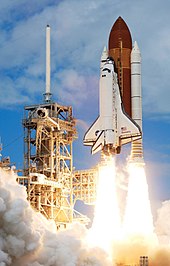
Launch of Space Shuttle Discovery at the start of STS-120.
The Space Shuttle became the major focus of NASA in the late 1970s and the 1980s. Originally planned as a frequently launchable, fully reusable vehicle, the design was changed to use an expendable external propellant tank to reduce development cost, and four Space Shuttle orbiters were built by 1985. The first to launch, Columbia, did so on April 12, 1981, the 20th anniversary of the first human spaceflight.[97]
The Shuttle flew 135 missions and carried 355 astronauts from 16 countries, many on multiple trips. Its major components were a spaceplane orbiter with an external fuel tank and two solid-fuel launch rockets at its side. The external tank, which was bigger than the spacecraft itself, was the only major component that was not reused. The shuttle could orbit in altitudes of 185–643 km (115–400 miles)[98] and carry a maximum payload (to low orbit) of 24,400 kg (54,000 lb).[99] Missions could last from 5 to 17 days and crews could be from 2 to 8 astronauts.[98]
On 20 missions (1983–1998) the Space Shuttle carried Spacelab, designed in cooperation with the European Space Agency (ESA). Spacelab was not designed for independent orbital flight, but remained in the Shuttle's cargo bay as the astronauts entered and left it through an airlock.[100] On June 18, 1983, Sally Ride became the first American woman in space, on board the Space Shuttle Challenger STS-7 mission.[101] Another famous series of missions were the launch and later successful repair of the Hubble Space Telescope in 1990 and 1993, respectively.[102]
In 1995, Russian-American interaction resumed with the Shuttle–Mir missions (1995–1998). Once more an American vehicle docked with a Russian craft, this time a full-fledged space station. This cooperation has continued with Russia and the United States as two of the biggest partners in the largest space station built: the International Space Station (ISS). The strength of their cooperation on this project was even more evident when NASA began relying on Russian launch vehicles to service the ISS during the two-year grounding of the shuttle fleet following the 2003 Space Shuttle Columbia disaster.
The Shuttle fleet lost two orbiters and 14 astronauts in two disasters: Challenger in 1986, and Columbia in 2003.[103] While the 1986 loss was mitigated by building the Space Shuttle Endeavour from replacement parts, NASA did not build another orbiter to replace the second loss.[103] NASA's Space Shuttle program had 135 missions when the program ended with the successful landing of the Space Shuttle Atlantis at the Kennedy Space Center on July 21, 2011. The program spanned 30 years with 355 separate astronauts sent into space, many on multiple missions.[104]
International Space Station (1993–present)
Main article: International Space Station
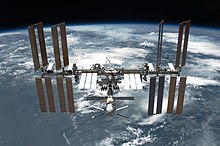
The International Space Station as seen from Space Shuttle Endeavour during STS-134.
The International Space Station (ISS) combines NASA's Space Station Freedom project with the Soviet/Russian Mir-2 station, the European Columbus station, and the Japanese Kibō laboratory module.[105] NASA originally planned in the 1980s to develop Freedom alone, but US budget constraints led to the merger of these projects into a single multi-national program in 1993, managed by NASA, the Russian Federal Space Agency (RKA), the Japan Aerospace Exploration Agency (JAXA), the European Space Agency (ESA), and the Canadian Space Agency (CSA).[106][107] The station consists of pressurized modules, external trusses, solar arrays and other components, which were manufactured in various factories around the world, and have been launched by Russian Proton and Soyuz rockets, and the US Space Shuttles.[105] The on-orbit assembly began in 1998, the completion of the US Orbital Segment occurred in 2009 and the completion of the Russian Orbital Segment occurred in 2010, though there are some debates of whether new modules should be added in the segment. The ownership and use of the space station is established in intergovernmental treaties and agreements[108] which divide the station into two areas and allow Russia to retain full ownership of the Russian Orbital Segment (with the exception of Zarya),[109][110] with the US Orbital Segment allocated between the other international partners.[108]
Long-duration missions to the ISS are referred to as ISS Expeditions. Expedition crew members typically spend approximately six months on the ISS.[111] The initial expedition crew size was three, temporarily decreased to two following the Columbia disaster. Since May 2009, expedition crew size has been six crew members.[112] Crew size is expected to be increased to seven, the number the ISS was designed for, once the Commercial Crew Program becomes operational.[113] The ISS has been continuously occupied for the past 21 years and 263 days, having exceeded the previous record held by Mir; and has been visited by astronauts and cosmonauts from 15 different nations.[114][115]
The station can be seen from the Earth with the naked eye and, as of 2022, is the largest artificial satellite in Earth orbit with a mass and volume greater than that of any previous space station.[116] The Soyuz spacecraft delivers crew members, stays docked for their half-year-long missions and then returns them home. Several uncrewed cargo spacecraft provide service to the ISS; they are the Russian Progress spacecraft which has done so since 2000, the European Automated Transfer Vehicle (ATV) since 2008, the Japanese H-II Transfer Vehicle (HTV) since 2009, the SpaceX Dragon from 2012 until 2020, and the American Cygnus spacecraft since 2013. The Space Shuttle, before its retirement, was also used for cargo transfer and would often switch out expedition crew members, although it did not have the capability to remain docked for the duration of their stay. Until another US crewed spacecraft is ready, crew members will travel to and from the International Space Station exclusively aboard the Soyuz.[117] The highest number of people occupying the ISS has been thirteen; this occurred three times during the late Shuttle ISS assembly missions.[118]
On March 29, 2019, the ISS was scheduled to have its first all-female spacewalk, but it was delayed; Jessica Meir and Christina Koch performed the first all-female spacewalk on October 18, as part of a lengthy series of upgrades to the ISS' power systems and physics observatories.[119][120][121] The ISS program is expected to continue to 2030.[122]
Commercial Crew Program (2011–present)
This section is an excerpt from Commercial Crew Program.[edit]

Logo since 2014
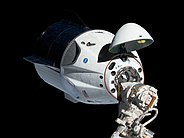
The Crew Dragon (left) and Starliner (right) approaching the ISS on their respective missions.
The Commercial Crew Program (CCP) provides commercially-operated crew transportation service to and from the International Space Station (ISS) under contract to NASA, conducting crew rotations between the expeditions of the International Space Station program. American space manufacturer SpaceX began providing service in 2020, using the Crew Dragon spacecraft, and NASA plans to add Boeing when its Boeing Starliner spacecraft becomes operational some time after 2022.
The spacecraft are owned and operated by the vendor, and crew transportation is provided to NASA as a commercial service. Each mission sends up to four astronauts to the ISS, with an option for a fifth passenger available. Operational flights occur approximately once every six months for missions that last for approximately six months. A spacecraft remains docked to the ISS during its mission, and missions usually overlap by at least a few days. Between the retirement of the Space Shuttle in 2011 and the first operational CCP mission in 2020, NASA relied on the Soyuz program to transport its astronauts to the ISS.
A Crew Dragon spacecraft is launched to space atop a Falcon 9 Block 5 launch vehicle and the capsule returns to Earth via splashdown in the ocean near Florida. The program's first operational mission, SpaceX Crew-1, launched on 16 November 2020. Boeing Starliner spacecraft will participate after its final test flight, launched atop an Atlas V N22 or Vulcan Centaur launch vehicle. Instead of a splashdown, a Starliner capsule will return on land with airbags at one of four designated sites in the western United States.
Development of the Commercial Crew Program began in 2011 as NASA shifted from internal development of crewed vehicles to perform ISS crew rotation to commercial industry development of transport to the ISS. A series of open competitions over the following two years saw successful bids from Boeing, Blue Origin, Sierra Nevada, and SpaceX to develop proposals for ISS crew transport vehicles. In 2014, NASA awarded separate fixed-price contracts to Boeing and SpaceX to develop their respective systems and to fly astronauts to the ISS. Each contract required four successful demonstrations to achieve human rating for the system: pad abort, uncrewed orbital test, launch abort, and crewed orbital test. Operational missions were initially planned to begin in 2017, with missions alternating between the two providers. Delays required NASA to purchase additional seats on Soyuz spacecraft up to Soyuz MS-17 until Crew Dragon missions commenced in 2020. Crew Dragon continues to handle all missions until Starliner becomes operational some time after 2022


















